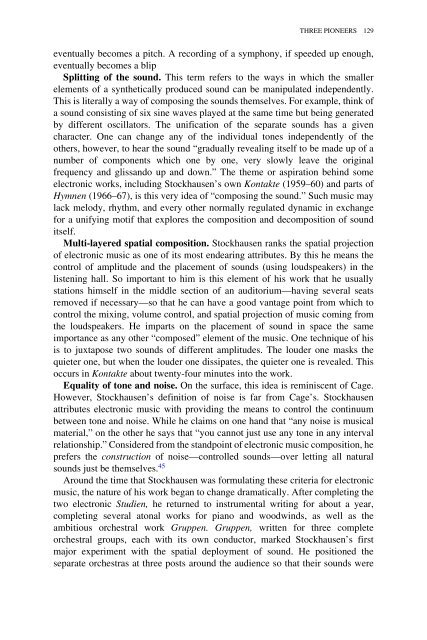Electronic and Experimental Music: Pioneers in ... - Aaaaarg
Electronic and Experimental Music: Pioneers in ... - Aaaaarg
Electronic and Experimental Music: Pioneers in ... - Aaaaarg
Create successful ePaper yourself
Turn your PDF publications into a flip-book with our unique Google optimized e-Paper software.
THREE PIONEERS 129<br />
eventually becomes a pitch. A record<strong>in</strong>g of a symphony, if speeded up enough,<br />
eventually becomes a blip<br />
Splitt<strong>in</strong>g of the sound. This term refers to the ways <strong>in</strong> which the smaller<br />
elements of a synthetically produced sound can be manipulated <strong>in</strong>dependently.<br />
This is literally a way of compos<strong>in</strong>g the sounds themselves. For example, th<strong>in</strong>k of<br />
a sound consist<strong>in</strong>g of six s<strong>in</strong>e waves played at the same time but be<strong>in</strong>g generated<br />
by different oscillators. The unification of the separate sounds has a given<br />
character. One can change any of the <strong>in</strong>dividual tones <strong>in</strong>dependently of the<br />
others, however, to hear the sound “gradually reveal<strong>in</strong>g itself to be made up of a<br />
number of components which one by one, very slowly leave the orig<strong>in</strong>al<br />
frequency <strong>and</strong> gliss<strong>and</strong>o up <strong>and</strong> down.” The theme or aspiration beh<strong>in</strong>d some<br />
electronic works, <strong>in</strong>clud<strong>in</strong>g Stockhausen’s own Kontakte (1959–60) <strong>and</strong> parts of<br />
Hymnen (1966–67), is this very idea of “compos<strong>in</strong>g the sound.” Such music may<br />
lack melody, rhythm, <strong>and</strong> every other normally regulated dynamic <strong>in</strong> exchange<br />
for a unify<strong>in</strong>g motif that explores the composition <strong>and</strong> decomposition of sound<br />
itself.<br />
Multi-layered spatial composition. Stockhausen ranks the spatial projection<br />
of electronic music as one of its most endear<strong>in</strong>g attributes. By this he means the<br />
control of amplitude <strong>and</strong> the placement of sounds (us<strong>in</strong>g loudspeakers) <strong>in</strong> the<br />
listen<strong>in</strong>g hall. So important to him is this element of his work that he usually<br />
stations himself <strong>in</strong> the middle section of an auditorium—hav<strong>in</strong>g several seats<br />
removed if necessary—so that he can have a good vantage po<strong>in</strong>t from which to<br />
control the mix<strong>in</strong>g, volume control, <strong>and</strong> spatial projection of music com<strong>in</strong>g from<br />
the loudspeakers. He imparts on the placement of sound <strong>in</strong> space the same<br />
importance as any other “composed” element of the music. One technique of his<br />
is to juxtapose two sounds of different amplitudes. The louder one masks the<br />
quieter one, but when the louder one dissipates, the quieter one is revealed. This<br />
occurs <strong>in</strong> Kontakte about twenty-four m<strong>in</strong>utes <strong>in</strong>to the work.<br />
Equality of tone <strong>and</strong> noise. On the surface, this idea is rem<strong>in</strong>iscent of Cage.<br />
However, Stockhausen’s def<strong>in</strong>ition of noise is far from Cage’s. Stockhausen<br />
attributes electronic music with provid<strong>in</strong>g the means to control the cont<strong>in</strong>uum<br />
between tone <strong>and</strong> noise. While he claims on one h<strong>and</strong> that “any noise is musical<br />
material,” on the other he says that “you cannot just use any tone <strong>in</strong> any <strong>in</strong>terval<br />
relationship.” Considered from the st<strong>and</strong>po<strong>in</strong>t of electronic music composition, he<br />
prefers the construction of noise—controlled sounds—over lett<strong>in</strong>g all natural<br />
sounds just be themselves. 45<br />
Around the time that Stockhausen was formulat<strong>in</strong>g these criteria for electronic<br />
music, the nature of his work began to change dramatically. After complet<strong>in</strong>g the<br />
two electronic Studien, he returned to <strong>in</strong>strumental writ<strong>in</strong>g for about a year,<br />
complet<strong>in</strong>g several atonal works for piano <strong>and</strong> woodw<strong>in</strong>ds, as well as the<br />
ambitious orchestral work Gruppen. Gruppen, written for three complete<br />
orchestral groups, each with its own conductor, marked Stockhausen’s first<br />
major experiment with the spatial deployment of sound. He positioned the<br />
separate orchestras at three posts around the audience so that their sounds were












